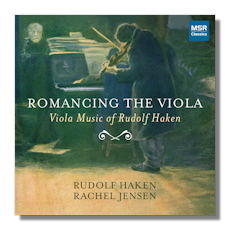
The Internet's Premier Classical Music Source
Related Links
- Haken Reviews
- Latest Reviews
- More Reviews
-
By Composer
-
Collections
DVD & Blu-ray
Books
Concert Reviews
Articles/Interviews
Software
Audio
Search Amazon
Recommended Links
Site News
 CD Review
CD Review
Rudolf Haken

Romancing the Viola
- Polonaise for Viola & Piano
- Für Fritz for Viola & Piano
- Fantasia in F Sharp minor for Viola & Piano
- Suite in A minor for Solo Viola
- Sonata in D minor for Viola & Piano
Rudolf Haken, viola
Rachel Jensen, piano
MSR Classics MS1609
Rudolf Haken is a composer, violist, violinist, pianist and professor of viola at the University of Illinois at Urbana-Champaign. Born in 1965, he became a child prodigy who went on to a successful concert career while concurrently gaining recognition as a composer of music in a Romantic or post-Romantic style. That description may well be too general, as you can also discern a neo-Classical voice in his works. If I can judge his style by the music on this disc alone, I would say he is cosmopolitan, absorbing mainly American and Western-European elements. While he has many conservative compositional traits, he is hard to pin down, as his music suggests hints of turn-of-the-20th-century American and European styles as well as, but to a lesser degree, Hindemith and perhaps other German composers of the first quarter or even first half of the 20th century. In any event, Haken is musically conservative and seemingly unabashed about it: he doesn't need every harmony to sound individual or every melody to take unexpected turns. But, on the flip side, don't assume his music is predictable or rife with clichès – it's not.
The Polonaise (1990) is utterly charming and witty, quirky and sassy too. It has real personality and its five minute length makes it a splendid and deserving piece to appear on many chamber concert programs. The writing for both viola and piano is skillful and the performances by Haken and pianist Rachel Jensen vital and beyond cavil.
Für Fritz (1980) is another work in much the same vein, only here there is also a very ingratiating whimsicality, a more playful sort of carefree character. The Fritz in the title, by the way, refers to none other than Fritz Kreisler. Again, this is another well-crafted short piece that other chamber organizations ought to consider for regular presentation. Performances are excellent once more.
The Fantasia in F-sharp minor (1981) is comprised of four short movements and lasts nearly eighteen minutes. It's a more serious piece than the preceding efforts, even though its moods are often fairly light. The first movement is largely buoyant but turns reflective at the end. The brief Scherzo is playful and very colorful. The lyrical Adagio is quite beautiful and somewhat dark, as the main theme soars into gray skies with a sense of regret. The finale is bright and lively, but near the end it seems to be descending into darkness but is rescued by the return of the chipper main theme. Again, writing for both viola and piano is highly skilled and performances are excellent. A very good work.
The Suite in A minor (1981) for solo viola is cast in seven short movements and styled after the Baroque suite, but with an extra Gigue. To my ears the writing here sounds quite challenging for the performer, but Haken is unfazed by the difficulties and deftly negotiates every treacherous turn and every technical hurdle with panache. Some listeners will regard the music as dry, but lovers of the viola will find it quite inventive, not least because it brings an imaginative take on the Baroque spirit into the 20th century and without distorting or satirizing it.
The final piece, the Sonata in D minor, is, at about a half hour, the longest and possibly most substantial work on the disc. The first movement contrasts a dark introductory theme marked Adagio with an energetic though not necessarily happy theme marked Vivace. There is an interesting fugal episode beginning nearly midway through that recalls Hindemith. The return of the opening theme sounds even darker in the latter half and the movement ends in an unsettled mood. This may be the best of the three movements. The central Adagio is over eleven minutes long and presents a lovely lyrical theme and several variations. The mood is brighter throughout, turning elegantly playful at times and later on a bit sentimental. The finale is lively and chipper in its main theme and second subject. But a gentle slow theme follows with a stately, almost hymn-like character. The materials are developed and recalled and the movement ends brilliantly. This work is certainly worthy of attention, and whether it can be called a masterpiece only time will tell. It's certainly masterly but I won't yet say I'm fully convinced it's a masterpiece. Again, performances by Haken and pianist Rachel Jensen are splendid.
In sum, there is much that is highly rewarding on this disc, and those interested in accessible contemporary chamber and/or viola music should fine this disc of interest. Sound reproduction is well balanced and clear and the album notes by Paul Groh are informative and thought-provoking.
Copyright © 2016, Robert Cummings


















